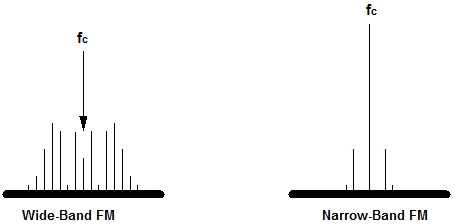The formula for an FM signal, s ( t ), is given by
 |
 |
 |
 |
 |
 |
 |
An important concept in the understanding of FM is that of Frequency Deviation. The amount of frequency deviation a signal experiences is a measure of the change in transmitter output frequency from the rest frequency of the transmitter. The rest frequency of a transmitter is defined as the output frequency with no modulating signal applied. For a transmitter with linear modulation characteristics, the frequency deviation of the carrier is directly proportional to the amplitude of the applied modulating signal. Thus an FM transmitter is said to have a modulation sensitivity, represented by a constant , k f , of so many kHz / V, k f = frequency deviation / V = k f kHz / V.
 |







